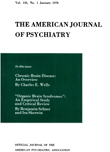The Role of Brain Dopamine in Behavioral Regulation and the Actions of Psychotropic Drugs
Abstract
By comparing biochemical and behavioral actions of d- and l- isomers of amphetamine, the authors show that locomotor hyperactivity, an animal model for the central stimulant effects of amphetamine, is mediated by brain norepinephrine. By contrast, stereotyped, compulsive gnawing behavior in rats, which resembles symptoms of amphetamine psychosis, appears to be regulated by brain dopamine. Since haloperidol, a potent blocker of dopamine receptors, is uniquely efficacious in treating Gilles de la Tourette's disease, the authors suggest that hyperactivity of dopamine systems in the brain may be a factor in the pathophysiology of this condition.
Access content
To read the fulltext, please use one of the options below to sign in or purchase access.- Personal login
- Institutional Login
- Sign in via OpenAthens
- Register for access
-
Please login/register if you wish to pair your device and check access availability.
Not a subscriber?
PsychiatryOnline subscription options offer access to the DSM-5 library, books, journals, CME, and patient resources. This all-in-one virtual library provides psychiatrists and mental health professionals with key resources for diagnosis, treatment, research, and professional development.
Need more help? PsychiatryOnline Customer Service may be reached by emailing [email protected] or by calling 800-368-5777 (in the U.S.) or 703-907-7322 (outside the U.S.).



